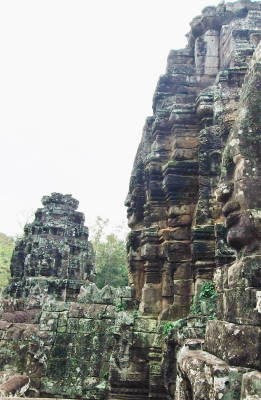23.11.2013


Visited Angkor Thom, a fortress town founded by King Jayavarman VII in the late 12th century. Its name means "large city."
The town contains the Bayon Temple, probably most famous for its gigantic faces carved in the stone Towers. Some theories claim that the faces are the representation of King Jayavarman VII.
Angkor Thom wurde vom König Jayavarman VII im späten 12.Jhdt als Hauptstadt gegründet. In seinen Grenzen liegen mehrere Klöster.
First view of Bayon Temple.
Bayon Tempel
In the entrance: Buddha statue under a golden parasol
Im Eingangsbereich unter einem Goldenen Schirm ist eine Buddhastatue.
As with Angkor Wat, the temple was built like a pyramid, with three layers. The faces look from the towers in all four directions.
Der in drei Ebenen gebaute Tempel ist Bekannt für seine in die vier Himmelsrichtungen blickenden Gesichter.
A happy fellow
Apsara in a niche

Bas-reliefs in the temple

From Bayon, the way lead next to the Baphoun Temple (11th century), a three-tiered pyramid construction dedicated to the Hindu god Shiva.
Der Baphoun, ein im 11.Jhdt erbauter Tempelberg ist dem Hindugott Shiva gewidmet.
View from the temple's second level (the top level was roped off for safety reasons).
Looking down on the entrance
Eingang
It was not exactly a safe walk round on the upper level...
Bei nur einem Seil als Sicherung ein durchaus sinnvoller Hinweis.
Walkway around the second level
2.Ebene
The galleries in the walkways were not always intended to accommodate the 21st century European-sized body.
Die Gänge wurden nicht für durchschnittlich große Europäer konstruiert.
Die Gänge wurden nicht für durchschnittlich große Europäer konstruiert.
The figure of a reclining Buddha is constructed in the brickwork on the west side of the temple.
Im 15.Jhdt wurde ein ca. 70m langer liegender Buddha zugefügt.
We passed through the old gateway leading to the king's palace...
Eingang zum Königspalast
...but there was nothing left but a heap of stones. Through the trees: first glimpse of Phimeanakas.
Dieser war aus Holz gebaut- heute gibt es kaum sichtbare Überreste- nur eine aus Stein erichtete Tempelanlage-Phimeanakas(10.Jhdt)- steht noch.
Phimeanakas, a 10th century Hindu temple. According to legend, the king spent the first watch of every night here with a woman thought to represent a Naga in the tower, when not even the queen was permitted to intrude (for the rest, see Wiki).
Der König musste dort jede Nacht eine Stunde mit einer "Naga" (in Frauengestallt) verbringen. Die Königin war der Zutritt verboten.
The walls are covered with moss and weeds
Exit from the town to the Terrace of the Elephants, used as a viewing platform by the king during public ceremonies.
Ausgang auf die Elefantenterrasse.
The grass space in front of the terrace was also used for sporting competitions.
Terrace of the Elephants
von hier aus beobachtete der König Sportkämpfe oder Militärparaden.
View across the arena
Tempel am gegenüber liegenden Waldrand.
Leaving Angkor Thom by the south gate. The bridge over the moat is adorned with figures representing good and evil, unfortunately most here covered up in building site.
Brücke zum Südtor von Angkor Thom- die Figuren repräsentieren links das Gute- rechts das Böse.
There's always good food to be found in Siem Reap!!
Es gibt nicht nur thailändische Küche in Siem Reap.
After so many temples, finished the evening exhausted at a Khmer dance performance - with accompanying buffet.
Am Abend nach den vielen "alten Steinen" ein Buffet mit traditionellen Tänzen.















































Keine Kommentare:
Kommentar veröffentlichen